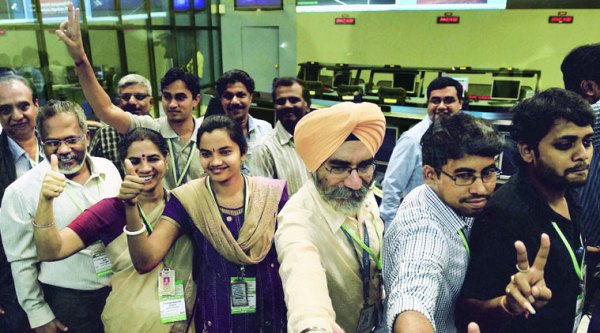Stay updated with the latest - Click here to follow us on Instagram
High anxiety, brief blackout…then Orbit
On day of expectancy at ISRO command centre, high tension finally dissolves into rapturous celebration.
 ISRO scientists and other officials celebrate the success of the mission at Mars Orbiter Command Network complex in Bangalore on Wednesday. ( Source: PTI )
ISRO scientists and other officials celebrate the success of the mission at Mars Orbiter Command Network complex in Bangalore on Wednesday. ( Source: PTI )
Moments after ISRO’s Mars Orbiter Mission spacecraft sent communication indicating that its insertion into an orbit around Mars was successful, a bunch of tense young scientists at the Mission Operations Centre let out shouts of delight. They had been waiting anxiously, wondering if the commands they had uploaded to the spacecraft would execute on time.
While there was a general sense of assurance that everything was in order — especially after the spacecraft automatically executed commands on September 22 to fire up the main engine that had been lying idle for 300 days — there was a sense of anxiety on Wednesday over execution of each of the commands uploaded to the spacecraft even among the senior scientists in the mission.
“There were some tense moments for us because we were receiving only low quantities of data at some key points on Wednesday when the engine was starting and its performance could not be estimated. Due to this there were a few anxious moments in the mission control room,” said mission director for the Mars Orbit Insertion operation Dr V Kesava Raju.
For most of the scientists at mission control, this was the first time they were tracking a spacecraft in deep space at a radio communication distance of 225 million km where a message takes 12½ minutes to travel one way. This communication lag resulted in scientists at ISRO for the first time preloading commands to the intelligent spacecraft 10 days in advance and hoping it would execute on cue.
“All the commands loaded on board were executed at the precise time they were meant to be. There were some anxieties because the eclipse began earlier than predicted and communication was available only for a short period after the engine started at 7.17 am making it difficult to determine performance,” Dr Raju said.
According to the scientists, the communication shutdown happened shortly after the engine provided a velocity of 177 metres per sec even as ISRO scientists were expecting more velocity at the end of a four-minute period when communication was available. “However calculations revealed that the engine was performing well for the limited period that data was available,” a mission operation scientist said.
“There is a sense of elation and relief when each command your team has created and uploaded to the spacecraft is executed perfectly,” said Bijay Kumar Rai, a mission operation scientist. “The feeling is the same as what you feel when your children grow up and behave the way you wanted them to,” said top mission scientist M Pitchamani.
A second key group whose work was at stake were the creators of the liquid engine, the main propulsion system. “Much of our worries over the engine were removed on September 22 when the test firing worked perfectly. On Wednesday too the engine performed well. In fact, it overperformed marginally. It is a testimony to the analytical ability of the scientists that things went precisely,” said K Sivan, director of the Liquid Propulsion System Centre.
Later, PM Narendra Modi said scientists at ISRO were initially reluctant to invite him to watch the insertion event due to anxieties. “The question arose as to where I should be on the morning of the Mars Orbit Insertion. There were scientists and they said it is a difficult job and nobody has succeeded in the first attempt. We don’t know whether to call you or not, they said. I said you don’t worry about it. If there is a failure it is my responsibility to be the first to console the scientists,” Modi said.







